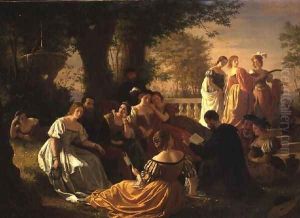Adolph Friedrich George Wichman Paintings
Adolph Friedrich George Wichman was a German sculptor born in 1820, who made significant contributions to the art world during his relatively short life, passing away in 1861. Wichman's artistic journey was deeply influenced by the cultural milieu of 19th-century Germany, a period marked by a resurgence of interest in classical art and the beginnings of the Romantic movement, which sought to emphasize emotion and individualism, a reaction against the Enlightenment's emphasis on reason and universality.
Wichman's work is characterized by its blend of classical elegance with Romantic sensibility, often focusing on themes of mythology, history, and human emotion. Despite the brevity of his career, his sculptures and reliefs resonated with the artistic and cultural currents of his time, earning him a place among the notable sculptors of the 19th century. His approach to sculpture was meticulous and imbued with a sense of life and dynamism, which was achieved through his keen observation of nature and human anatomy, a hallmark of the period's artistic endeavors.
Unfortunately, specific details about Wichman's life, including his education and personal life, are not as well-documented as those of his contemporaries. This lack of comprehensive biographical information has led to Wichman being somewhat overshadowed by other artists of his era. However, his surviving works continue to be studied and appreciated for their artistic merit and contribution to the development of sculpture in the 19th century. Wichman's legacy is that of an artist who, despite the constraints of his time and the brevity of his life, managed to capture the complexity of human emotions and the beauty of the natural world in his sculptures, leaving a lasting impact on the art world.

